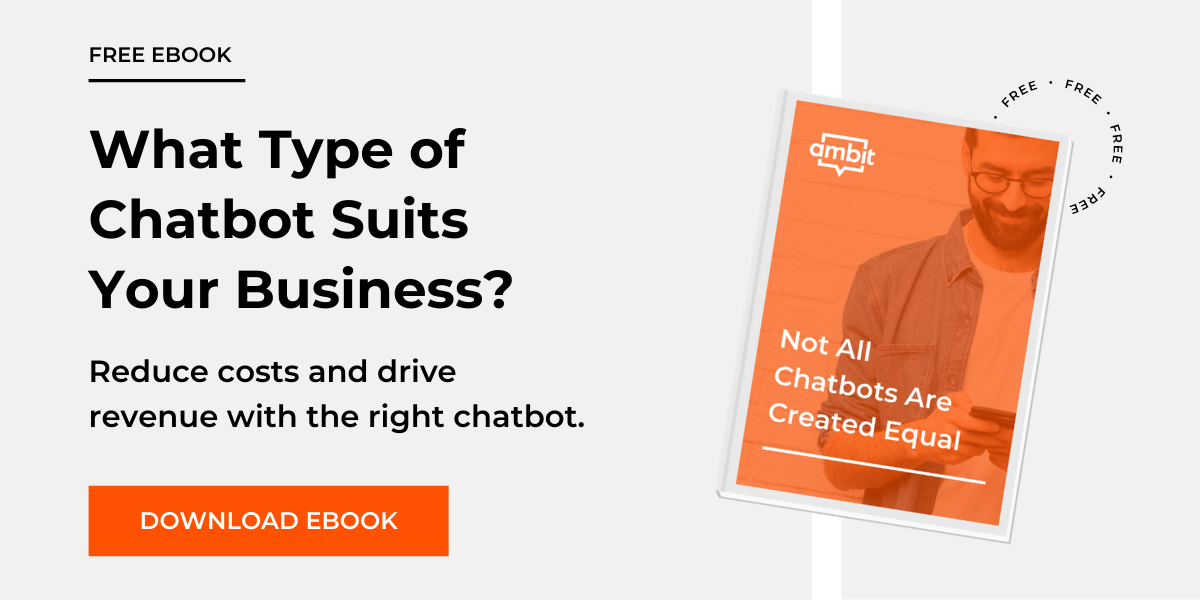Chatbots are the talk of the town. They’re one of the hottest topics in the technology world today.
Like any new technology, much of the fact and fiction gets jumbled up. This leads to a number of myths and misconceptions that sway popular opinion, particularly among decision makers.
We set the record straight on 5 of the most common myths about chatbots so you can be confident of deploying one in your business today.
→ Noel Leeming generates 2.2X more upsells with
AI-powered chatbot [Case Study]
Contents
1. Implementing a chatbot requires too much time and resource
2. It’s better to build your own chatbot than to buy
3. Chatbots don’t generate ROI
4. The technology isn’t up to scratch
5. Chatbots prevent access to humans
Myth #1: Implementing a chatbot requires too much time and resource
A common misconception is that implementing a chatbot requires the availability of a large IT department and highly qualified AI & machine learning experts, solution architects, and data scientists on the company’s side.
And this is true... if you are custom building your own chatbot (more on this later).
If you partner with a solution provider who knows their stuff, implementing a chatbot actually requires minimal time and resources, and can be easily deployed in a matter of weeks.
Here’s some proof:
Noel Leeming, New Zealand’s largest electronics retailer, implemented their web-based chatbot in the middle of the 2020 COVID-19 pandemic in just 12 days.
That’s right - a fully functioning AI-powered chatbot with integrations into existing business systems in less than two weeks.
→ Read the full case study here
Advanced solution providers essentially provide a platform that has everything set up and ready to go.
Most of what is required during the implementation is the configuration of the conversations to match the decided use case(s). There is very little to no coding effort required, meaning IT and development resources are minimal.
Easy to use, intuitive tools (think ‘drag and drop’ style functionality) make it easy for users to design, build and test conversations quickly. Teams can move fast to get their chatbot up and running without any technical expertise.
The key is also to start with a single use case, get your chatbot live, collect data, and iterate as you go (we’ll touch on this in more detail a bit later).
Myth #2: It’s better to build your own chatbot than to buy
Aside from the exorbitant costs associated with building from scratch, here’s why a platform is your best bet.
a) Custom-built solutions are slow to develop and deploy
Just thinking of what goes into it is exhausting - trust us, we know. A platform is cost-effective and faster to deploy. Low code platforms, like Ambit, require minimal development and allow you to implement a fully functioning chatbot quickly, that delivers better bang for your buck, and accelerated time-to-value.
b) Custom-built chatbots require ongoing resources, time and money
It’s not just the initial build you have to think about. Don’t forget the requirements to maintain and improve the platform, minimise technical debt, fix bugs, run QA and testing, and ensure it scales with your business. A solution provider will take care of this for you.
c) Specialised components
Then there are the specialised components that go into developing a platform from the ground up. This is often overlooked by businesses that choose to build.
Capabilities such as artificial intelligence, machine learning algorithms, Natural Language Processing/Understanding, neural linguistics, integrations with key business systems, the list goes on. Acquiring the knowledge and skills to develop these is expensive and time-consuming. A platform has these capabilities built-in already.
d) Constant improvements
A best-in-class platform constantly improves over time - and not at your own expense.
Access to new features at a regular cadence based on extensive R&D is guaranteed. This free’s your team up to focus on other projects. All the technical aspects are looked after for you (you’re welcome), and you also get access to an industry-leading team of product specialists who are responsible for ensuring you get the most out of the solution as your business grows.
Unless you have time, skills and cash to burn to build a custom chatbot, a best-in-class platform will return a better ROI every single time. It’s like ERP systems; sooner rather than later, those who build their own end up crawling back to a best-of-breed solution. Save yourself the headaches!
Myth #3: Chatbots don’t generate a return on investment
This is the biggest misconception of all.
Any lapse in ROI is often down to how the technology has been implemented, rather than the limitations of the technology itself.
Businesses that utilise the technology to its full potential are generating incredible returns. Here are a few examples:
- Chatbots generates 2.2X more ecommerce upsells
- Chatbots can cut customer service costs by 30%
- Noel Leeming sees 16X ROI from their chatbot, Nola
- Vector’s chatbot deflects ~2,000 customer service calls per month
- Retailer drops cost to serve to $0.47
And there are so many more (if you need further proof, let’s chat).
So how do businesses ensure their chatbot generates a return on investment?
One of the mistakes businesses make when implementing a chatbot is they clamber anything and everything in at the beginning of the project. They pour time and money into developing the ‘perfect’ chatbot that can do everything under the sun, before setting it live and forgetting about it.
This approach is slow, neglectful, and costly.
It's important to start small, get your chatbot up early, gather & analyse user data, learn fast, and iterate on the fly.
Why? Rather than sinking time into building the entire chat experience up front and making a host of assumptions, your chatbot is live faster, shortening the time-to-value, and uses data to drive decision making on the areas your chatbot should develop next. ROI continues to rise as your chatbots’ skill set develops over time.
Conversation design also plays an important role in the value a consumer and business receives from its chatbot.
What use cases does your chatbot specialise in, how are its conversations designed, how deep do they go, do they exist to support existing customers or convert new customers? Do they align with your use case and goals? The list goes on.
It’s a specialised skill to design chatbot conversations that achieve businesses goals and expectations. That’s why we at Ambit have a dedicated team of experts to advise our customers on designing conversations that drive a measurable return on investment.
**Note: If you’d like to know what goes into creating great digital conversations let us know, we’d be happy to share our experiences, or download our Conversation Design eBook here.
Myth #4: The technology isn’t up to scratch
Like any new innovation, it's fair to say the early instances of chatbots left a lot to be desired.
As developers and businesses navigated this new technology, consumers were often left with underwhelming experiences, and businesses looking to point the blame.
Much of this is historical and not a reflection on the quality standards of modern chatbots. It also comes down to the use cases and expectations decided by the business, and how the technology is utilised to deliver on these.
Through AI and machine learning, chatbots have evolved exponentially since their inception. Today they're smarter than ever, more refined, and able to provide value to an array of use cases on demand.
Sophisticated data processing means today's chatbots are more accurate and reliable, learning from each and every interaction to grow their capabilities faster.
The most advanced chatbots utilise NLP/NLU to better interpret and understand the way humans speak (let's face it, even us humans have trouble understanding each other at times!).
Today's chatbots understand the complex nuances of human language, such as tone, sentiment, context, and intent to respond appropriately, solve more intricate enquiries, and provide better customer experiences.
**Note: We wrote an eBook on the different types of chatbots available, from simple FAQ bots to AI-powered Digital Employees. You can find out which type of chatbot suits your business here.
Myth #5: Chatbots prevent access to human agents
The last myth is that by using chatbots, consumers no longer have access to human agents.
By integrating a chatbot with a live chat system businesses provide a fully seamless handover from chatbot to a human when the situation requires it. This also extends to email support and call-back functions.
Many chatbots utilise AI and machine learning technology. They’re smart enough to detect enquiries that are more complicated and best solved with human interaction.
The chatbot calls on a human agent standing by to take over the conversation and provides them with all the context and information gathered. This brings the human agent up to speed on the enquiry immediately, enabling them to assist in real-time.
Chatbots exist to augment humans, not displace them. By taking care of high volume routine tasks, they free up human agents to focus on higher priorities to add more value. Working hand-in-hand they are the perfect combination to deliver customer service at scale.
So there you have it - the truth about chatbots
Their popularity as a customer service solution has grown exponentially - and there’s good reason for it.
By automating customer conversations, chatbots have proven themselves to free up human agents to be more productive, reduce support costs, and act as an additional channel to increase sales.
Of course, if you need further proof, we’re only a conversation away.




